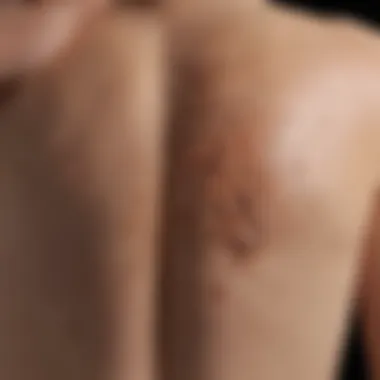Evaluating Clorox as a Treatment for Scabies


Intro
The incidence of scabies continues to present a significant challenge in dermatological health. This condition, caused by the Sarcoptes scabiei mite, leads to severe itching and discomfort. Various treatment options are available, but many do not completely eliminate the problem. One product that has sparked interest is Clorox, a bleach commonly used for cleaning and disinfecting. While its role in treating scabies is not well established, exploring its potential efficacy is essential for those seeking solutions.
This article will delve into different aspects of this topic, aiming to clarify whether Clorox can safely combat scabies. By understanding key terminologies related to scabies, examining innovative treatments, and evaluating the implications of using bleach products, readers can become better informed in managing scabies effectively and safely.
Prolusion to Scabies
Scabies is a dermatological condition caused by a mite known as Sarcoptes scabiei. This tiny parasite burrows into the skin, leading to intense itching and rash. Understanding scabies is crucial because it affects not just individual health, but can also impact public health, primarily in crowded living conditions. The significance of examining the efficacy of Clorox, a common household disinfectant, in managing scabies lies in the need for effective treatment options. Traditional treatments are often prescribed, yet the effectiveness and safety of alternative methods require evaluation.
Understanding Scabies
Scabies is characterized by its insidious nature. The mite can spread easily through prolonged skin-to-skin contact. Once a person is infested, the symptoms may take weeks to appear, causing potential delay in seeking treatment. This delay can exacerbate the spread of the condition, making awareness and understanding of scabies vital.
Symptoms and Transmission
The primary symptom of scabies is itching, which worsens at night. Additional signs can include:
- Rashes that appear as red bumps or blisters
- Skin sores due to scratching
- Thickened, crusty skin in severe cases (crusted scabies)
Transmission commonly occurs through close physical contact, but it can also spread via infested clothing, bedding, and other personal items. Its high infectivity highlights the need for effective treatment measures to not only alleviate symptoms but also prevent further outbreaks.
"Effective management of scabies requires a comprehensive understanding of its nature and connections in social contexts."
Recognizing the symptoms and transmission modalities can aid in prompt intervention, reducing the likelihood of widespread infestations.
Traditional Treatments for Scabies
The significance of traditional treatments for scabies lies in their proven effectiveness and established use in clinical settings. Understanding these methods provides a foundation for comparison with alternative approaches, such as the potential use of Clorox. Traditional treatments often focus on killing the scabies mites and alleviating the symptoms associated with the infestation. This section will delve into various topical and oral medications as well as treatment protocols that have been widely accepted and utilized in addressing scabies.
Topical Medications
Topical medications serve as the frontline defense against scabies. Products like permethrin cream or lindane lotion are commonly prescribed. These therapies work by targeting the mite directly on the skin.
- Permethrin is a synthetic chemical that paralyzes and kills scabies mites.
- Lindane, while effective, carries risk of neurotoxicity and is often prescribed when other treatments fail.
Using these medications requires careful application and following the instructions thoroughly. Typically, they should be applied over the entire body, from the neck down, and left for a specific time before washing off. Considerations include that they may cause irritation, and there may be a need to treat individuals at the same time to prevent reinfestation. The ease of application and efficacy make these topical treatments a common choice.
Oral Medications
Oral medications are an alternative when topical treatments are ineffective or not feasible. Ivermectin is the most notable oral medication used for scabies treatment.
- Ivermectin works by affecting the nervous system of the scabies mite, ultimately leading to its death.
This approach is particularly advantageous for those with crusted scabies or individuals who cannot tolerate topical applications due to skin sensitivities. Another benefit is its ability to treat widespread infestations efficiently. However, it is only available by prescription and should be used under medical guidance.
Treatment Protocols
Treatment protocols are critical for achieving the best outcomes in managing scabies. Health professionals recommend specific steps to enhance the efficacy of treatments. These protocols typically include:


- Initial Treatment: Administering either topical or oral medication as prescribed.
- Follow-up Treatment: A second dose may be necessary, particularly for oral ivermectin, to ensure that all mites are eradicated.
- Environmental Control: Cleaning bedding, clothing, and living spaces is crucial in preventing reinfestation.
Adherence to these protocols can significantly influence the treatment's success. Over time, the systematic use of these methods fosters an environment that is hostile to scabies mites and helps in sustaining the results achieved through medication.
Engaging in traditional treatments for scabies not only addresses the immediate issue but allows individuals to approach their care from a holistic perspective, ensuring both physical and psychological well-being.
Chemical Composition of Clorox
Understanding the chemical composition of Clorox is essential in evaluating its potential efficacy in treating scabies. Clorox, as a brand, is recognized primarily for its bleaching and disinfecting properties. It is critical to analyze its specific ingredients and properties to determine whether it can address the root causes of scabies, which is caused by the mite Sarcoptes scabiei. This examination highlights both the advantages and the associated risks of using such a chemical product for treating a skin condition.
Ingredients in Clorox
Clorox products contain several key ingredients, with sodium hypochlorite being the most significant one. This is the active ingredient, which is responsible for its disinfecting qualities. Aside from sodium hypochlorite, Clorox formulations often include water, sodium chloride, and sodium hydroxide in varying quantities. Each of these components interacts with the others, contributing to the effectiveness of the product against bacteria and viruses, but their impact on scabies is less certain.
- Sodium Hypochlorite: Main active component, effective against pathogens.
- Water: Solvent that helps distribute the other ingredients.
- Sodium Chloride: Common salt, sometimes used to stabilize solutions.
- Sodium Hydroxide: Helps adjust pH levels to maintain product stability.
These ingredients function collectively; however, their combined effects on human skin and parasites like scabies need careful consideration.
Antimicrobial Properties
Sodium hypochlorite, as the primary active ingredient, possesses notable antimicrobial properties. It is effective at breaking down cell walls of various microbes, which leads to their destruction. This action is well documented in controlling bacteria and viruses. However, when it comes to scabies mites, these properties may not translate directly to efficacy.
Research suggests that while sodium hypochlorite can eliminate some forms of pathogens, its effectiveness against the scabies mite specifically is not guaranteed. The scabies mite is a resilient organism, and direct application of high concentrations of bleach can potentially cause skin irritation.
Key considerations regarding antimicrobial properties of Clorox:
- While effective against some pathogens, it lacks targeted action against scabies.
- Risk of skin burns or irritation if applied directly.
- No well-documented studies confirm its effectiveness against Sarcoptes scabiei.
"It is crucial to approach Clorox's use in treating scabies with caution, taking into account both its potential benefits and significant risks to the skin."
Can Clorox Kill Scabies?
The discussion surrounding whether Clorox can effectively eliminate scabies is pivotal in understanding potential treatment options for this persistent condition. Scabies is caused by a microscopic mite that burrows into the skin, leading to intense itching and discomfort. Traditional treatments often involve topical or oral medications specifically designed to target these mites. However, some may consider alternative solutions, like Clorox, due to its widespread antimicrobial properties. Clorox, a brand of bleach, is commonly regarded for its cleaning capabilities, but this does raise questions about its safety and efficacy in dermatological applications.
Mechanism of Action
Clorox contains sodium hypochlorite as its active ingredient. Though its primary use is as a disinfectant, the antimicrobial properties might suggest potential against scabies. Sodium hypochlorite can disrupt cellular membranes and is known to kill various microorganisms. However, the mechanism is complex when used on human skin. Direct contact with concentrated bleach can lead to skin irritation and damage rather than effectively targeting scabies mites. The harshness of this compound raises important considerations regarding its application.
Research Findings
Research on the effectiveness of Clorox against scabies is limited and often inconclusive. Studies primarily focus on traditional medications. Current literature indicates that while Clorox can kill certain pathogens on surfaces, its effectiveness when applied to skin is not well-documented. The potential for skin irritation or chemical burns is significant, creating a risk versus benefit scenario. Furthermore, because scabies treatment usually requires consistency over several days, reliance on bleach could lead to adverse effects rather than treatment success.
Expert Opinions
Experts in dermatology and parasitology generally advise against using Clorox for scabies treatment. According to dermatologists, the risk of chemical burns and irritation outweighs any unproven benefits. Topical treatments like permethrin or oral ivermectin are well-established and clinically proven to target scabies effectively. Medical professionals recommend these approved therapies rather than off-label use of bleach products. This reinforces the importance of following established treatment guidelines and consulting healthcare providers for appropriate solutions.
Combining safe preventive measures alongside proven treatment options will provide the best outcome for managing this condition.
Safety Considerations


The exploration of Clorox as a potential treatment for scabies introduces significant considerations regarding safety. Understanding these safety factors is crucial, especially when addressing a skin condition that already causes discomfort and distress.
Use of Clorox can lead to serious reactions, and it is important to weigh the possible benefits against the risks associated with its application. Safety considerations include potential skin irritation, effects on sensitive skin, and long-term implications of exposure to such chemicals.
Risk of Skin Irritation
Clorox, containing sodium hypochlorite, is a strong chemical. When applied to skin, it can cause irritation. Symptoms may include redness, burning, or itching. This risk is heightened with prolonged exposure or improper dilution. Precautions must be taken if considering its use as a treatment for scabies to prevent worsening skin conditions.
"Skin irritation from chemical exposure can lead to additional medical issues, which further complicate scabies treatment."
Healthcare providers often suggest a patch test on a small skin area before large-scale application. This can help gauge individual sensitivity to the compound. Individuals with existing skin conditions should be particularly cautious, as their skin may react more unpleasantly.
Impact on Sensitive Skin
For many, sensitive skin presents an additional challenge. Conditions like eczema or psoriasis can be exacerbated by harsh compounds found in products like Clorox. Just as medications vary in efficacy from person to person, reactions to topical applications can also differ widely.
Bleach-based products, including Clorox, can penetrate the skin barrier and disrupt its natural moisture content. Those with sensitive skin may experience significant dryness or flaking. Enhanced sensitivity could also lead to a severe response, making it essential to evaluate whether the potential benefits outweigh these dangers.
Long-term Effects
The long-term implications of using Clorox on skin are not fully understood, but are a source of concern. Regular application could lead to cumulative skin damage or sensitization. In sensitive populations, this includes developing an allergic reaction over time. Potential impacts may manifest through chronic skin issues that complicate treatment for scabies.
Alternatives that are less aggressive on skin and still effective against scabies should be explored. Overall, it is critical to consider safety as a primary factor when assessing treatment options. Clorox may not be suitable for everyone, and professional medical advice is paramount.
Alternative Treatments for Scabies
Alternative treatments for scabies are vital in the discussion around managing this condition, especially in light of increasing resistance to conventional therapies. As people search for effective solutions that minimize side effects, these alternatives can offer different approaches. They are worth considering for various reasons, from efficacy to accessibility.
Many patients seek options beyond traditional pharmaceuticals due to allergies, sensitivities, or a lack of effective results. Some alternative treatments may promise a gentler approach, especially for those with sensitive skin. However, it is crucial to remember that efficacy can vary widely among individuals.
Natural Remedies
Natural remedies for scabies can provide a holistic approach, intended to soothe the skin or combat the mites. Some of the most popular natural treatments include:
- Tea Tree Oil: Known for its antimicrobial properties, tea tree oil may inhibit the scabies mite. It is often mixed with carrier oils before application.
- Neem Oil: Extracted from the neem tree, this oil has been recognized in traditional medicine for its anti-parasitic qualities. Some studies suggest its effectiveness against pests.
- Aloe Vera: This plant is frequently used for its calming effects on skin irritation. While it may not kill mites directly, Aloe vera can support skin healing post-treatment.
- Essential Oils: Oils such as lavender or peppermint may provide soothing sensations and are thought to have insect repellent properties. They should be mixed with a carrier oil before use.
Although natural remedies can be appealing, scientific evidence for their effectiveness specifically on scabies is limited. Consulting healthcare providers before initiating any alternative treatment is advisable.
Alternative Pharmaceuticals
In addition to natural treatments, there are alternative pharmaceuticals that may serve as effective options for managing scabies. These alternatives may be suitable for individuals who do not respond to typical treatments like permethrin or ivermectin. Some notable options include:
- Crotamiton: Available as a cream or lotion, crotamiton may be used for those who are sensitive to traditional treatments. Its application may help relieve itching.
- Benzyl Benzoate: Often used in other regions, benzyl benzoate can be effective against scabies and may be available in various concentrations. Caution should be taken to follow application guidelines.
- Lindane: This insecticide is sometimes prescribed as a last resort. Its use has declined due to potential neurological side effects but remains a consideration in serious cases.
As with any medication, potential side effects and contraindications should be carefully evaluated. Consulting with a healthcare professional is recommended before beginning any treatment regimen, whether natural or pharmaceutical.
"Alternative treatments can offer valuable options, but understanding their implications is key to effective management."
Preventive Measures Against Scabies


Preventive measures against scabies are critical not only to reduce the risk of infestation but also to halt the potential spread of this contagious condition. Understanding and implementing these measures can considerably lower the likelihood of acquiring or transmitting scabies. It is essential for individuals, especially those in close quarters such as farming communities where living conditions are often shared, to prioritize prevention.
Hygiene Practices
Maintaining proper hygiene plays a vital role in preventing scabies. Here are some key practices to adopt:
- Regular Hand Washing: Wash hands frequently with soap and water, especially after contact with others.
- Bathing: Regular bathing can help remove any potential mites from the skin. Use warm water and mild soap.
- Clothing Hygiene: Change and wash clothes frequently, especially after any known exposure to an infested person. Use hot water and dry on high heat to kill any mites.
- Personal Items: Avoid sharing personal items such as towels, bedding, and clothing. Each household member should have their own designated items.
Implementing these practices not only diminishes the chances of an infestation but also cultivates a heightened sense of awareness regarding personal health.
Environmental Control
Environmental control also plays a significant role in the fight against scabies. The following actions can help create a safer living environment:
- Deep Cleaning: Regularly clean common areas and frequently touched surfaces, inlcuding furniture, to minimize the presence of mites. Use disinfectants that effectively kill bacteria and other pathogens.
- Vacuuming: Vacuum carpets, rugs, and upholstery thoroughly and frequently to remove any potential mite remnants. Dispose of vacuum bags immediately to prevent recontamination.
- Isolation of Infested Items: For items believed to be infested, seal them in a plastic bag for at least 72 hours. This duration allows time for mites to die off without a host.
"Prevention is always better than treatment. Investing time in hygiene and environmental control can reap substantial benefits regarding scabies management."
Incorporating these preventive measures is crucial for anyone in a community potentially exposed to scabies. Not only do they protect individuals, but they also contribute to the overall health of the community.
Culminations
The section of conclusions plays a critical role in this article. It serves to distill the extensive analysis and information provided throughout the text into a coherent and easily understandable narrative. By summarizing key findings regarding the efficacy of Clorox in treating scabies, the conclusions also highlight the practical implications of the research discussed. Readers are often looking for concise, actionable insights that can guide their decision-making, thus making this section essential.
Summary of Findings
In evaluating the use of Clorox against scabies, several important points emerged:
- Ineffectiveness as a Treatment: While Clorox contains bleach which has certain antimicrobial properties, it is not effective in treating scabies. Scabies is caused by a mite that burrows into the skin, requiring targeted treatments rather than broad-spectrum disinfectants.
- Safety Risks: The potential for skin irritation and other adverse effects poses a significant concern. People with sensitive skin or those prone to dermatological issues should avoid using bleach directly on the skin.
- No Scientific Support: Research studies and expert opinions consistently indicate that Clorox cannot replace established treatments such as permethrin or ivermectin. The consensus is clear—traditional medications are the recommended course of action.
Recommendations
Based on the findings, several recommendations arise:
- Adhere to Approved Treatments: Individuals suffering from scabies should prioritize the use of medically approved treatments. This ensures efficacy and safety, reducing risks associated with improper care.
- Consult Healthcare Professionals: Before attempting any treatments, including home remedies or alternative options, individuals should consult healthcare professionals for guidance.
- Focus on Hygiene Practices: Emphasize preventive measures, particularly hygiene practices and environmental control, to minimize transmission risks. This approach is crucial in keeping scabies at bay, especially in communal settings.
Key Takeaway: While Clorox is a powerful antimicrobial agent, its application against scabies is neither effective nor recommended. Users should rely on established dermatological treatments tailored for this condition.
Further Reading and Resources
In the context of managing scabies, accessing credible and detailed resources is crucial for both understanding the condition and exploring treatment options. Further reading aids in reinforcing knowledge gained from the article while offering additional perspectives and insights. This section presents various books, journals, and online platforms where readers can find reliable information regarding scabies and its treatments, particularly with regard to the use of Clorox.
Books and Journals
Books and journals provide a wealth of detailed research findings and expert opinions. They serve as foundational texts for medical professionals and those seeking a deep understanding of dermatological conditions.
- Dermatology textbooks often cover the pathology of scabies, its symptoms, and the latest treatment methodologies. One notable example is "Dermatology" by Jean L. Bolognia, which is well regarded in the medical community.
- Peer-reviewed journals, such as the "Journal of the American Academy of Dermatology" and "British Journal of Dermatology," publish studies on scabies treatments including chemical and non-chemical methods, thereby offering empirical evidence.
- Guidelines published by dermatological societies are another vital resource. They summarize current best practices for treating scabies and evaluating alternative solutions like Clorox.
Online Resources and Support Groups
The internet hosts numerous platforms that offer valuable guidance and community support. These online resources can help individuals cope better with the challenges of scabies.
- Websites like Wikipedia and Britannica provide background information on scabies, how it spreads, and various treatment alternatives.
- Support groups on Reddit offer a platform for individuals to share personal experiences, treatment outcomes, and emotional support. Visiting the subreddit for health-related issues can be particularly enlightening.
- Health organizations, such as the American Academy of Dermatology, have online portals filled with guidance for both healthcare professionals and patients, ensuring that the information is current and trustworthy.
- On Facebook, groups dedicated to skin health can yield peer support and tips on managing scabies, fostering a community environment despite the isolation the condition may create.
Overall, engaging with diverse sources enhances understanding and equips individuals with information essential for informed decision-making. By consulting various educational materials, readers can ascertain the efficacy of Clorox in combating scabies as well as exploring broader management strategies.















